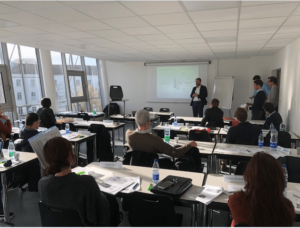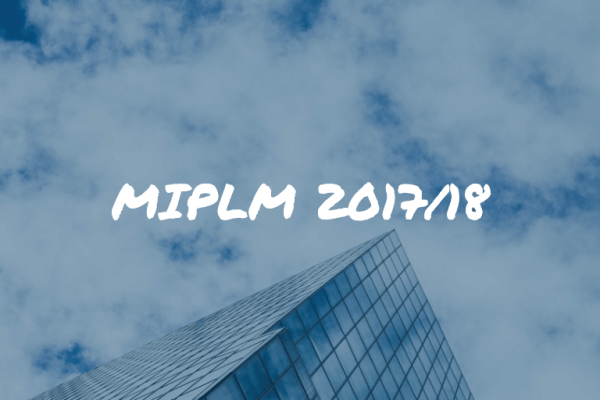MIPLM 2017-18 starts with lecture module on IP strategy development and case study presentations
MIPLM program starts in January 2018 with 18 students from eight different countries in Europe and Asia. 1st module of MIPLM focusses on strategy development and the economy of IP.
 In the first part of this module, under the headline “Future of IP”, different scenarios are discussed how IP could be further developed especially under the framework of upcoming 4th industrial revolution. The lectures comprises also questions about the knowledge economy and the role of IP in economic studies.
In the first part of this module, under the headline “Future of IP”, different scenarios are discussed how IP could be further developed especially under the framework of upcoming 4th industrial revolution. The lectures comprises also questions about the knowledge economy and the role of IP in economic studies.
In the second part different ways are presented, how corporate strategies can be evaluated and IP strategies are developed to be aligned with competitive strategic approaches. Especially the question, how IP strategies should be addressed to C-Level managers and could be effectively communicated, is discussed. Different examples from Apple, Danone and Nestlé, Vorwerk Thermomix, Pfizer, Beiersdorf, Sony, JVC, Netflix, GoreTex, Intel, Procter&Gamble help to illustrate the key learnings form a practical side.  In intensive group work within international an interdisciplinary backgrounds the students learn, how to integrate patents, trademarks and design rights in a systematic way to create effective spheres of exclusivity around customer benefits accompanied of premium price strategies in b-to-b and b-to-c markets.
In intensive group work within international an interdisciplinary backgrounds the students learn, how to integrate patents, trademarks and design rights in a systematic way to create effective spheres of exclusivity around customer benefits accompanied of premium price strategies in b-to-b and b-to-c markets.
IP strategy development case study: the functional food revolution – from humble yoghurt to individual probiotic super food.
 People are increasingly looking for foods which solve their health problems. In recent years, manufacturers have developed products with additives they claim to be beneficial for people’s health and wellbeing. This has resulted in a new category of products referred to as “functional foods” – and probiotic yoghurt has pioneered this revolution.
People are increasingly looking for foods which solve their health problems. In recent years, manufacturers have developed products with additives they claim to be beneficial for people’s health and wellbeing. This has resulted in a new category of products referred to as “functional foods” – and probiotic yoghurt has pioneered this revolution.
Probiotic yoghurt contains specific bacterial cultures which supposedly promote their consumers’ health. Most people are unaware of what probiotics actually are. French food manufacturer Danone recognized the opportunities provided by a “little bottle full of bacteria” early on and developed Actimel.
Current trends permit the development of new business models for functional food: Health and fitness-conscious individuals take great care of what they eat and adjust their diet specifically to their lifestyle. They continuously monitor their fitness and other health data by using wearable tracking devices such as fitness wristbands. The data collected by these “wearables” is stored by the relevant providers and can be analyzed in order to gain insights related to training progress, etc.
Simultaneously, these data are used to optimize people’s diet. The increasing digitization of value chains enables manufacturers to produce and sell customized products which meet the individual requirements of their customers. This also permits the addition of suitable health-promoting substances in order to customize functional foods to individual customers’ needs. The health and fitness data recorded by the wearables can be analyzed and used in order to manufacture products with the optimal formulation for each individual user at any given time.
Customized functional food could be offered to customers in the form of subscriptions. This means that the customer places an order to continuously buy customized yoghurt in a specific frequency. As soon as the next delivery is due the actual fitness / health status is automatically retrieved from the wearable manufacturers’ databases and the individual yoghurt is produced. Yet besides the individualized composition and production of the yoghurt there is another major challenge for setting up an adequate logistics structure. Due to the fact that yoghurt is perishable food the cooling chain must not be broken until the product reaches the customer.
Hence “normal direct delivery to the customers’ homes” as offered by logistics service providers is not applicable. For this reason a different distribution channel can be created by partnering with fitness studios. It can be assumed that a majority of health / fitness conscious people regularly attends such a fitness studio. For this reason the customized yoghurt could be delivered to these places and could be immediately be cooled there. Additionally such partnerships could create great credibility for the value proposition of health and fitness supporting nutrition.
Case study presentations:
- Task 1:
Please give an overview of the case on hand in brief words.
Please explain which kind of competitive advantage will be created in the business model behind functional yoghurt. Please describe the goals of setting up a 360° IP strategy for individualized functional yoghurt. Which kind of generic IP-strategy might be applicable for the case on hand. Please refer as well to the “fortress monopoly” as to the “value-added monopoly” and give reasons for your answers. Please describe the role of IP as an instrument for protecting the resources of a firm as well as for designing market positions.
Presented by:
- Andreas Hanssen, Onsagers AS, Oslo Norway
- Jan-Christian Schütte, Siemens AG, Munich, Germany
- Nancy Gallou, Kerry Group PLC, Luxembourg
- Frederik Golks, Robert Bosch GmbH, Stuttgart, Germany
- Seijin Kang, Korea Copyright Commission, Hanoi, Vietnam
- Task 2:
Please outline the business model behind functional yoghurt. For this purpose please distinguish the resource perspective and the market perspective of the business model. Please explain the concept of a 360° IP strategy and of a 360° Objectives Matrix. Please develop a 360° objectives matrix for the given case.
Presented by:
- Humberto Alonso Canchila Acuna, Airbus, Defense & Space GmbH, Taufkirchen, Germany
- Manuel Ebert, Siemens AG, Munich, Germany
- Sunmi Auh, Samsung Electronics, Seoul Korea
- Reda Bouchenak, Sanofi, Paris, France
- Marina Leterrier, Fermentalg SA, Libourne, France
- Guillaume Stern, Teva Pharmaceuticals International gmbH, Basel, Switzerland
- Shije Ye, former Federal Patent Court, Munich, Germany
- Task 3:
Please explain the principle of value creation by means of IP. In your opinion, which impacts should IP develop in the individualized functional yogurt business model? What measures must be taken to create the desired IP impact? In the present case, please develop ideas for areas in which IP rights should be designed and explain why these IPRs would be useful for the conversion of the business model. How can it be ensured that the IP impacts can be internalized? How could IP also serve to fulfil this task? For the present case study, please give examples of how IP can used to be generate a unique communication position.
Presented by:
- Tom Tassignon, Philips International B.V., Eindhoven, Netherlands
- Mauro Lattuada, Ecole Polytechnique Federal, Lausanne, Switzerland
- Chiara Silvana, Novaliq, Heidelberg, Germany
- Moritz Breitenbach, B. Braun Melsungen AG, Melsungen, Germany
- Achim Bankamp, Siemens AG, Munich, Germany



